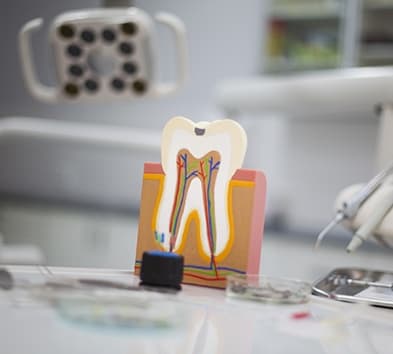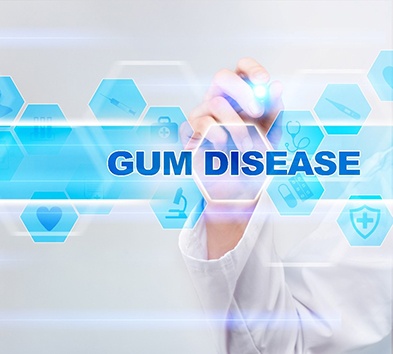Periodontal Therapy – Alexandria, IN
Got Sensitive Gums?
Consider Gum Therapy!

The gums are an essential part of oral health that many people don’t take into consideration when practicing oral care. Without healthy gums, your risk for tooth loss goes up dramatically. In fact, gum disease is the leading cause of tooth loss in adults, so if you’re suffering from gum disease, now is the perfect time to pay Dr. Martinez a visit. With periodontal therapy in Alexandria, IN, he can get you back on the path towards oral health, stop the infection, and reduce your symptoms. Contact Martinez Dentistry today to get started on your treatment!
Why Choose Martinez Dentistry for Periodontal Therapy?
- Soft Tissue Laser Therapy Available Via the Odyssey
- Antibiotic Therapy Used to Accelerate Healing
- Nitrous Oxide and Oral Conscious Sedation Available
Scaling & Root Planing

To stop the symptoms of your gum disease, we perform a two-pronged treatment known as scaling and root planing. The scaling process involves removing plaque and tartar from tooth enamel that sits above and below the gum line. Afterward, we perform the root planing process, which involves smoothing out your tooth roots so they can more effectively reattach to teeth. Both work to reduce the sensitivity, the inflammation, and the recession of your gum tissue. With our soft tissue laser, we can conserve more healthy gum tissue and reduce the amount of time needed for healing in between treatments.
Antibiotic Therapy

As you undergo scaling and root planing, you’ll need to visit our dental office every three to four months so that the gums have time to heal. Before you leave, we’ll perform antibiotic therapy to promote the healing of your gum tissue in between visits. Application of the antibiotics is fast, simple, and incredibly effective. By targeting the pockets that form between teeth, we can reduce the risk of future infection occurring and accelerate the healing process.
Gum Disease FAQs

Although gum disease can be avoided, it’s the leading cause of tooth loss in the U.S. Thankfully, we can save your smile with periodontal therapy. It’s normal to have a few concerns before you’re ready to commit to a treatment. We’ll take the time to explain the process during your initial consultation. While you wait for your appointment, here are the answers to a few of the most common questions patients ask us to help ease any apprehensions.
What are the risks of untreated gum disease?
The symptoms of gum disease might not seem alarming at first; however, bleeding and swollen gums can quickly manifest into larger problems. The infection will destroy the supporting structures of your teeth, which can ultimately lead to tooth loss. The complications of the infection don’t stop there. The bacteria from gum disease can enter your bloodstream. As it circulates throughout your body, it increases your risk of several health issues, like cardiovascular disease, Alzheimer’s disease, and diabetic complications.
What causes gum disease?
Gum disease is an infection that occurs in the gingival tissue from improper oral hygiene habits. Without an adequate brushing and flossing routine, plaque and tartar will accumulate near the gum line, which hosts the harmful bacteria. It will infect and irritate the soft tissue, leading to an infection. Besides poor oral hygiene habits, there are other factors that can increase your risk of periodontal disease, like smoking or drinking alcohol in excess.
What are the symptoms of gum disease?
Depending on the stage of the infection, you can experience a variety of symptoms, including:
- Red, swollen, or bleeding gums
- Receding gum line
- Tooth sensitivity
- Chronic bad breath
- Pus near the roots
- Loose teeth
- Bad taste in the mouth
- Changes to the alignment of your teeth
How can I prevent gum disease?
Although gum disease is common, there are several things you can do to lower your risk of the infection, such as:
- Use a soft-bristled toothbrush and nonabrasive toothpaste to brush twice daily.
- Clean all surfaces of your teeth for at least two minutes.
- Use high-quality dental floss to clean in between each tooth nightly.
- Don’t smoke or drink alcohol in excess.
- Visit your dentist at least twice a year for a cleaning and checkup.
- Eat a balanced diet that’s limited in sugars.
What are the stages of gum disease?
There are three stages of gum disease, which are determined by the depths of the gingival pockets:
- Gingivitis: The earliest stage of the infection can be treated without causing any long-term damage using a deep cleaning and changes to your oral hygiene routine.
- Periodontitis: If gingivitis isn’t treated, it will manifest into periodontitis, which can begin destroying the supporting structures of your teeth. You’ll need an aggressive treatment plan to prevent it from worsening, like scaling and root planing.
- Advanced Periodontitis: The final stage of gum disease can cause tooth loss, as well as general health issues. Besides treating the infection, we’ll also need to repair any damage it has caused, like replacing missing teeth.
